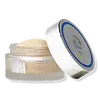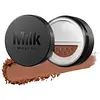What's inside
What's inside
 Key Ingredients
Key Ingredients

 Benefits
Benefits

 Concerns
Concerns

 Ingredients Side-by-side
Ingredients Side-by-side

Water
Skin ConditioningDimethicone/Vinyl Dimethicone Crosspolymer
Skin ConditioningGlycerin
HumectantHdi/Trimethylol Hexyllactone Crosspolymer
Silica
AbrasiveNiacinamide
SmoothingHydroxyacetophenone
AntioxidantPotassium Sorbate
PreservativeSodium Benzoate
MaskingSynthetic Fluorphlogopite
Phenoxyethanol
PreservativeDehydroacetic Acid
PreservativeIsoceteth-10
EmulsifyingPropanediol
SolventHydrolyzed Hyaluronic Acid
HumectantMica
Cosmetic ColorantTriethoxycaprylylsilane
Fomes Officinalis Extract
Skin ProtectingCI 77492
Cosmetic ColorantCI 77491
Cosmetic ColorantIron Oxides
Water, Dimethicone/Vinyl Dimethicone Crosspolymer, Glycerin, Hdi/Trimethylol Hexyllactone Crosspolymer, Silica, Niacinamide, Hydroxyacetophenone, Potassium Sorbate, Sodium Benzoate, Synthetic Fluorphlogopite, Phenoxyethanol, Dehydroacetic Acid, Isoceteth-10, Propanediol, Hydrolyzed Hyaluronic Acid, Mica, Triethoxycaprylylsilane, Fomes Officinalis Extract, CI 77492, CI 77491, Iron Oxides
Mica
Cosmetic ColorantSilica
AbrasiveLauroyl Lysine
Skin ConditioningMagnesium Myristate
Zea Mays Starch
AbsorbentLens Esculenta Seed Extract
Skin ProtectingBakuchiol
AntimicrobialNiacinamide
SmoothingPersea Gratissima Fruit Extract
EmollientWater
Skin ConditioningCaprylic/Capric Triglyceride
MaskingMaltodextrin
AbsorbentSodium Hyaluronate
HumectantEthylhexylglycerin
Skin ConditioningPhenoxyethanol
PreservativeIron Oxides
CI 77007
Cosmetic Colorant
 Reviews
Reviews

Ingredients Explained
These ingredients are found in both products.
Ingredients higher up in an ingredient list are typically present in a larger amount.
Mica is a naturally occurring mineral used to add shimmer and color in cosmetics. It can also help improve the texture of a product or give it an opaque, white/silver color.
Serecite is the name for very fine but ragged grains of mica.
This ingredient is often coated with metal oxides like titanium dioxide. Trace amounts of heavy metals may be found in mica, but these metals are not harmful in our personal products.
Mica has been used since prehistoric times throughout the world. Ancient Egyptian, Indian, Greek, Roman, Aztec, and Chinese civilizations have used mica.
Learn more about MicaNiacinamide is a multitasking form of vitamin B3 that strengthens the skin barrier, reduces pores and dark spots, regulates oil, and improves signs of aging.
And the best part? It's gentle and well-tolerated by most skin types, including sensitive and reactive skin.
You might have heard of "niacin flush", or the reddening of skin that causes itchiness. Niacinamide has not been found to cause this.
In very rare cases, some individuals may not be able to tolerate niacinamide at all or experience an allergic reaction to it.
If you are experiencing flaking, irritation, and dryness with this ingredient, be sure to double check all your products as this ingredient can be found in all categories of skincare.
When incorporating niacinamide into your routine, look out for concentration amounts. Typically, 5% niacinamide provides benefits such as fading dark spots. However, if you have sensitive skin, it is better to begin with a smaller concentration.
When you apply niacinamide to your skin, your body converts it into nicotinamide adenine dinucleotide (NAD). NAD is an essential coenzyme that is already found in your cells as "fuel" and powers countless biological processes.
In your skin, NAD helps repair cell damage, produce new healthy cells, support collagen production, strengthen the skin barrier, and fight environmental stressors (like UV and pollution).
Our natural NAD levels start to decline with age, leading to slower skin repair, visible aging, and a weaker skin barrier. By providing your skin niacinamide, you're recharging your skin's NAD levels. This leads to stronger, healthier, and younger looking skin.
Another name for vitamin B3 is nicotinamide. This vitamin is water-soluble and our bodies don't store it. We obtain Vitamin B3 from either food or skincare. Meat, fish, wheat, yeast, and leafy greens contain vitamin B3.
The type of niacinamide used in skincare is synthetically created.
Learn more about NiacinamidePhenoxyethanol is a preservative that has germicide, antimicrobial, and aromatic properties. Studies show that phenoxyethanol can prevent microbial growth. By itself, it has a scent that is similar to that of a rose.
It's often used in formulations along with Caprylyl Glycol to preserve the shelf life of products.
Silica, also known as silicon dioxide, is a naturally occurring mineral. It is used as a fine, spherical, and porous powder in cosmetics.
Though it has exfoliant properties, the function of silica varies depending on the product.
The unique structure of silica enhances the spreadability and adds smoothness, making it a great texture enhancer.
It is also used as an active carrier, emulsifier, and mattifier due to its ability to absorb excess oil.
In some products, tiny microneedles called spicules are made from silica or hydrolyzed sponge. When you rub them in, they lightly polish away dead skin layers and enhance the penetration of active ingredients.
Learn more about SilicaWater. It's the most common cosmetic ingredient of all. You'll usually see it at the top of ingredient lists, meaning that it makes up the largest part of the product.
So why is it so popular? Water most often acts as a solvent - this means that it helps dissolve other ingredients into the formulation.
You'll also recognize water as that liquid we all need to stay alive. If you see this, drink a glass of water. Stay hydrated!
Learn more about WaterThis ingredient is a combination of red, black, and yellow iron oxide pigments. This combination of colors is usually found in foundation, because it results in a "skin" color.